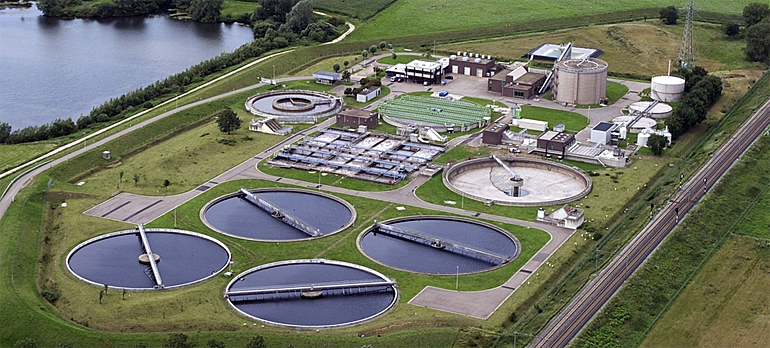Comprehending Wastewater Treatment Processes and Their Environmental Impact
The intricacies of wastewater therapy procedures play a critical role in mitigating ecological obstacles linked with water air pollution. Each stage, from preliminary to innovative treatments, is designed to resolve certain impurities, ultimately securing both public health and water ecosystems.
Overview of Wastewater Treatment
Just how is wastewater changed into a risk-free source for the environment? Wastewater therapy is a critical process made to eliminate impurities from made use of water, thereby protecting public health and shielding environments. This process starts with the collection of wastewater from residential, industrial, and industrial resources, which is after that guided to therapy centers.
At these facilities, various physical, chemical, and organic approaches are used to treat the wastewater. Subsequently, biological therapies, such as activated sludge processes, make use of microbes to break down natural issue.
The dealt with effluent can be safely discharged into natural water bodies or recycled for irrigation and commercial functions, promoting source preservation. Furthermore, the therapy process creates biosolids, which can be repurposed as fertilizers or soil changes, further enhancing sustainability.
Stages of Treatment Procedures
The wastewater therapy process commonly contains 3 main stages: initial, key, and secondary therapy. Each stage offers a distinctive duty in minimizing the contaminant lots and making sure the effluent satisfies environmental requirements before discharge.

The main treatment stage concentrates on the physical splitting up of put on hold solids from the wastewater. With sedimentation, larger particles settle at the base of sedimentation tanks, developing sludge, while lighter materials, such as oils and greases, float to the surface and are skimmed off. This process dramatically decreases the organic and not natural load in the wastewater.
Secondary therapy is an organic procedure intended at further decreasing the concentration of natural issue. This phase is essential for achieving the required biochemical oxygen need (FIGURE) reduction, eventually leading to cleaner effluent all set for discharge or more treatment.

Advanced Therapy Technologies
Following the secondary treatment procedures, progressed therapy technologies play a crucial role in further enhancing the quality of treated wastewater. These modern technologies are designed to get rid of residual contaminants that are not properly removed throughout key and secondary therapies, making sure the effluent satisfies rigid regulatory requirements.
Amongst the commonly utilized advanced therapy techniques are membrane purification, reverse osmosis, and progressed oxidation processes. Membrane filtering, consisting of microfiltration and ultrafiltration, works in separating fine particles, pathogens, and colloids from the water (Wastewater). Reverse osmosis makes use of semi-permeable membrane layers to remove dissolved solids, leading to high-grade water suitable for numerous applications
Advanced oxidation processes (AOPs) employ strong oxidants to break down natural pollutants, including pharmaceuticals and personal treatment products that are resistant to standard treatment. These techniques enhance the biodegradability of complex substances, promoting their removal.
An additional considerable technology is using biological nutrient removal procedures, which specifically target nitrogen and phosphorus, preventing eutrophication in receiving water bodies. Overall, advanced treatment innovations are necessary for accomplishing greater degrees of filtration, promoting water reuse, and securing public health while resolving the difficulties related to wastewater administration.
Environmental Benefits of Therapy
Various ecological benefits emerge from reliable wastewater treatment processes that add to ecosystem health and wellness and sustainability. Primarily, these procedures significantly reduce the release of dangerous pollutants into all-natural water bodies, read what he said which assists maintain aquatic ecosystems. By getting rid of pollutants such as hefty metals, nutrients, and microorganisms, dealt with wastewater mitigates the risk of waterborne diseases and advertises biodiversity in marine continue reading this atmospheres.
Furthermore, wastewater therapy centers frequently use advanced technologies that enable water recycling and reuse. This technique not just saves fresh water resources yet likewise reduces the demand on natural water materials. Enhanced nutrient removal from wastewater can likewise stop eutrophication, a procedure that brings about algal blooms and subsequent oxygen exhaustion in aquatic systems.
Furthermore, reliable therapy procedures can minimize greenhouse gas discharges, especially methane and laughing gas, which are usually released during unattended wastewater disintegration. By catching and utilizing biogas from anaerobic digesters, centers can transform waste right into renewable energy, thus contributing to a decrease in nonrenewable fuel source dependence.
Difficulties and Future Patterns
While the environmental advantages of wastewater therapy are clear, numerous challenges continue that hinder optimal outcomes in this area. One major concern is aging facilities, which often results in inefficiencies and boosted functional costs - Wastewater. Many therapy plants were created years back, and their capabilities do not straighten with modern demands, which consist of more stringent governing requirements and greater volumes of wastewater as a result of urbanization

Looking in advance, there is a growing focus on resource healing and circular economic climate principles within wastewater treatment. Developments such as anaerobic food digestion, which can create biogas, and progressed filtration innovations are gaining traction. These approaches not only enhance therapy efficiency however also advertise sustainability.
Ultimately, attending to these challenges needs collaboration among stakeholders, investment in innovation, and a commitment to recurring research study. By embracing these trends, the wastewater treatment field can progress to meet the demands of a transforming setting and society.
Verdict
Finally, wastewater treatment processes play a vital role in boosting environmental high quality and public health and wellness. The multi-stage therapy structure, combined with advanced modern technologies, effectively alleviates pollution and promotes sustainable water administration. By resolving recurring impurities and minimizing nutrition overflow, these procedures add to the conservation of water communities and the reduction of greenhouse gas emissions. Continued innovations and adaptations in treatment methods will be crucial for conquering arising difficulties and making sure the sustainability of all-natural sources (Wastewater).